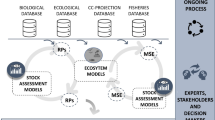Abstract.
The paper discusses methods for estimating the value of commercially exploited fish stocks and the cost of exploiting them. Methods which are recommended in the System of National Accounting (SNA) satellite system and the System for Integrated Environmental and Economic Accounting (SEEA) and relevant for this task are discussed. The paper questions the relevance of some of these methods. It argues for the integration of economic accounting for wild fish stocks with estimation of efficient management of them. Using biological and economic data makes it possible to produce consistent estimates of the value of fish stocks and the cost of exploiting them. These estimates are useful for national accounting and for guiding management of fisheries. This method allows estimation of the cost of inefficiency of fisheries management besides estimation of the cost of depletion. The different methods are illustrated using data on commercial fisheries in Iceland and the fish stocks that they exploit. It is shown that even if all methods are based on market valuation and use only objective data they lead to very different outcomes.
Similar content being viewed by others
References
Arnason R. (1995). The Icelandic Fisheries: Evolution and Management of a Fishing Industry. Fishing News Books.
R. Arnason (2003) A Comparison of Fisheries Management Costs in Iceland, Norway and Newfoundland W.E. Schrank R. Arnason R. Hannesson (Eds) The Cost of Fisheries Management Ashgate Aldershot
P. Bartelemus (1998) The Value of Nature: Valuation and Evaluation in Environmental Accounting K. Uno P. Bartelmus (Eds) Environmental Accounting in Theory and Practice Kluwer Academic Publishers Dordrecht, Boston and London 263–307
Clark, C. W. (1990). Mathematical bioeconomics. 2nd edition. John Wiley & Sons.
Concerted Action, Promotion of Common Methods for Economic Assessment of EU Fisheries (1999). Economic Performance of Selected European Fishing Fleets, Annual Report 1999. (FAIR PL97-3541).
A. Danielsson (1997) ArticleTitleFisheries management in Iceland Ocean & Coastal Management 35 IssueID2–3 121–135
A. Danielsson (2000) Integrated Environmental and Economic Accounting for Commercial Exploitation of Wild Fish Stocks Proceedings of the Tenth International Conference of the International Institute of Fisheries Economics and Trade Corvallis, Oregon
A. Danielsson (2002) Biological Information, Profitability of Fisheries and Lease and Asset Prices for ITQs in Iceland Proceedings of the Eleventh International Conference of the International Institute of Fisheries Economics and Trade Wellington, New Zealand
A. Danielsson G. Stefanson F.M. Baldursson K. Thorarinsson (1997) ArticleTitleUtilization of the Icelandic Cod Stock in a Multispecies Context Marine Resource Economics 12 IssueID4 329–344
Eurostat (1996). Nordic Natural Resource and Environmental Accounting. A joint report from the statistical offices in Finland, Norway, Sweden, Denmark and Iceland, Luxembourg.
FAO (2004). Handbook of National Accounting – Integrated Environmental and Economic Accounting for Fisheries, Studies in Method Series F, No. 97.
O. Flaaten K. Heen K.G. Salvanes (1995) ArticleTitleThe Invisible Resource Rent in Limited Entry and Quota Managed Fisheries: The Case of Norwegian Purse Seine Fisheries Marine Resource Economics 10 341–356
S.D. Flåm (1993) Norsk “sildeformue” SEFOS Notat, 88 University of Bergen Norway
Flåm, S. D., T. Kjelby, and T. Rödseth (1997). Fiskeformue og forvaltningsstragi. In: K. A. Brekke, Ø. Lohne and T. Rödseth, ed., Økonomi og økologi. Verktøy for en bærekraftig politikk, Oslo, Norway.
Hass, J. L. and K. Ø. Sørensen (1998). Norwegian Economic and Environment Accounts (NOREEA) Project. Final report to Eurostat.
Helgason, Th. and M. Kenward (1985). Estimation of Fishing Power with Relation to Exploited Biomass. ICES, Council Meeting, D:7.
Kjelby, T. (1993). De norske torskefiskeriene som nasjonalformue, SEFOS Notat 90, University of Bergen.
Lutz, E. and M. Munasinghe (1994). Environmental accounting and valuation in the marine sector. In: P. B. Payoyo, ed., Ocean Governance: Sustainable Development of the Seas. United Nations: University Press.
MRI (2001). Nytjastofnar sjávar og umhverfispættir 2001 – Aflahorfur fiskveiðiárið 2001/2002 (Annual report of the MRI). Hafrannsóknastofnun, Iceland.
NEI (1999). Þróun sjávarútvegs, kvótakerfið, auðlindagjald og almenn hagstjórn (Fisheries development, the quota system, resource tax and general economic policy): a report produced by the National Economic Institute (NEI) for the Committee on Natural ces and published in Auðlindanefnd – Áfangaskýrsla með fylgiskjölum, Available (in Icelandic) at http://brunnur.stjr.is/interpro/for/for.nsf/Files/3kafli/file/3kafli.pdf.
NEI (1999a). Auðlindarenta í íslenskum sjávarútvegi og dreifing hennar (Resource rent in Icelandic fisheries and its distribution). A report produced by the National Economic Institute (NEI) for the Committee on Natural Resources, unpublished.
Nordisk Ministerråd (1996). Nordiska naturresurs- och miljöräkenskaper – delrapport 1. TemaNord 1996:563, Copenhagen.
Repetto R. (1999). Creating Asset Accounts for a Commercial Fishery: A Case Study of the Atlantic Sea Scallop Fishery’, unpublished.
SEEA Handbook (1993). United Nations, Integrated Environmental and Economic Accounting. Interim version. Studies in Methods. Handbook of National Accounting. Series F, No. 61. New York.
SNA Handbook (1993). Commission of the European Communities – Eurostat, International Monetary Fund, Organization for Economic Cooperation and Development, United Nations and World Bank. System of National Accounts 1993. Brussels/Luxembourg, New York, Paris, Washington, DC.
United Nations (1993). United Nations Conference on Environment and Development, Rio de Janeiro, 3–14 June 1992, Vol. I.
United Nations (2000). Department of Economic and Social Affairs, Statistical Division and United Nations Environmental Programme, Integrated Environmental and Economic Accounting – An Operational Manual, New York.
Vinnuhópur um nýtingu fiskistofna (1994): (Governmental committee on the exploitation of fish stocks). Hagkvæm nýting fiskistofna (Efficient exploitation of fish stocks): Reykjavik.
M.L. Weitzman (1976) ArticleTitleOn the Welfare Significance of National Product in a Dynamic Economy Quarterly Journal of Economics 90 IssueID1 156–162
Willmann, R. (1997): Integrated Environmental and Economic Accounting in Fisheries, Discussion paper, FAO.
Author information
Authors and Affiliations
Corresponding author
Rights and permissions
About this article
Cite this article
Daníelsson, Á. Methods for Environmental and Economic Accounting for the Exploitation of Wild Fish Stocks and their Applications to the Case of Icelandic Fisheries. Environ Resource Econ 31, 405–430 (2005). https://doi.org/10.1007/s10640-005-2176-5
Accepted:
Issue Date:
DOI: https://doi.org/10.1007/s10640-005-2176-5



